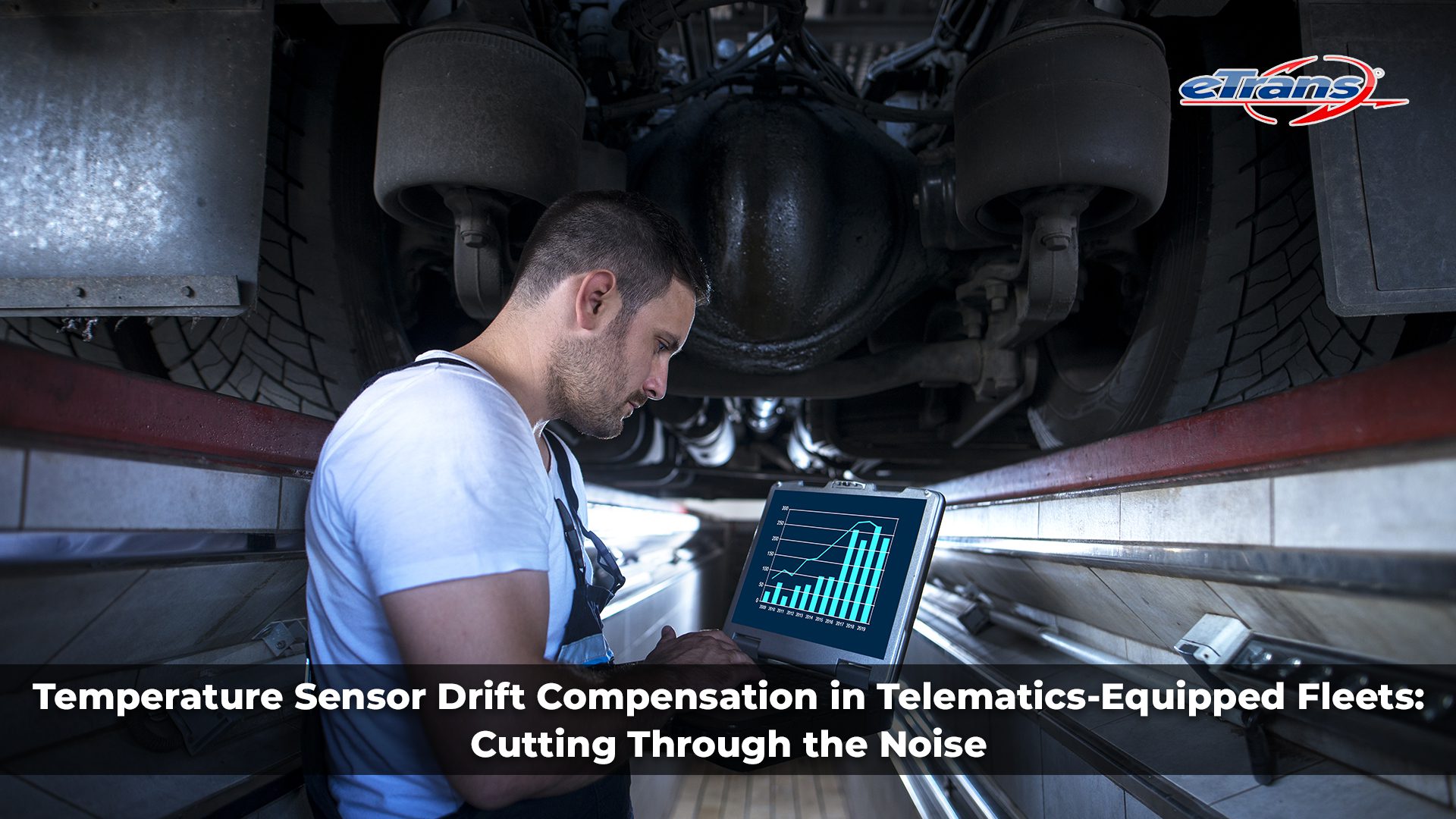The most difficult part of fleet management is fuel cost, driver shortages, or traffic jams. As such, a small temperature sensor buried in a joint trailer can quietly make or waste millions of rupees in cargo.
That tiny component is meant to keep pharmaceuticals, frozen food, and critical goods safe, which often doesn’t stay perfectly accurate forever. Over time, its readings start to “drift.” And guess what? That innocent drift can ruin vaccine shipments, trigger false compliance alarms, or completely mess with real-time telematics data.
In India, the cold chain industry is booming. Trucks move from scorching 45°C Rajasthan highways to refrigerated cargo at 2°C within hours. These extreme transitions stress sensors and create thermal cycling effects that cause accuracy to slip. Left unchecked, drift can transform reliable systems into compliance nightmares. Spoilt pharma shipments, rejected consignments, and regulatory penalties? Not exactly what fleet owners sign up for.
This article cuts through the noise and explains how drift compensation algorithms, sensor calibration, and even futuristic AI-powered fleet management IoT solutions can stop drift in its tracks. Stick around and you’ll learn not only why drift happens but also how Kalman filter compensation, predictive maintenance analytics, and edge computing telematics help fleets maintain accuracy, trust, and profitability.
Physical Causes of Temperature Sensor Drift
Drift doesn’t show up like a flat tire or an engine knock, it creeps in slowly. The physical causes lie in environmental stress impact on sensor components. Metals expand and contract under extreme heat and cold, and connectors corrode over time. These changes distort the electrical properties of Resistance Temperature Detectors (RTDs) or thermistors, leading to misreadings.
In India, reefer trucks driving from Delhi to Chennai face temperature swings of over 40°C in a single trip. This constant thermal cycling effect wears sensors down. Dust, moisture, and poor wiring maintenance add insult to injury. A sensor that once read “2°C” with perfect accuracy might now show “3.5°C.” Seems small, right? For pharmaceutical logistics compliance, that half-degree deviation can make a vaccine consignment unusable.
Thermistor accuracy degradation happens faster than most fleet managers expect. Add in long hauls, power fluctuations, and vibration stress, and you’ve got the perfect recipe for drift. Understanding these causes helps fleets prepare. By investing in durable hardware and planning drift compensation algorithms, operators can cut costs, prevent downtime, and avoid compliance headaches.
Types of Temperature Sensors Used in Indian Fleet Telematics
Not all sensors are created equal, and that’s where choices get tricky. Most Indian fleets rely on three major sensor types: thermistors, RTDs, and semiconductor sensors.
● Thermistors: Cheap and compact but highly sensitive to thermal cycling effects. Over time, their resistance shifts significantly, causing drift. Great for short-term use, risky for long-term cold chain monitoring.
● Resistance Temperature Detectors (RTDs): The gold standard for precision and consistency. Less prone to drift, but expensive. They also need precise sensor calibration, making them ideal for high-value cargo like pharma or biotech.
● Semiconductor Sensors: Found in integrated telematics modules, they balance cost and accuracy. Digital outputs make them perfect for modern fleet management IoT solutions where cloud-based temperature monitoring is key.
Each sensor type carries trade-offs. Reefer fleets transporting frozen seafood might tolerate thermistors, while pharma fleets must go for RTDs to stay within ±0.5°C accuracy. The real challenge is balancing budget constraints with regulatory needs. Get it wrong, and drift silently eats away at your KPIs.
Calibration and Drift Compensation Techniques
Here’s the truth: calibration is not a one-and-done affair. It’s an ongoing battle against drift. Fleet managers who skip calibration eventually pay for it with rejected loads and angry clients.
Traditional calibration involves comparing a sensor to a lab-grade reference at set intervals. But in Indian conditions, that’s impractical. Fleets are turning to advanced techniques like:
● Dual-sensor referencing: Two sensors cross-check each other, reducing reliance on a single point of failure.
● Auto-calibration firmware: Built into telematics modules, this software corrects drift in real time without human intervention.
● Cloud-based temperature monitoring: Sensors upload data for comparison against baseline models, flagging anomalies instantly.
● In-situ comparisons: Sensors inside trailers compare readings to known reference zones, adjusting outputs automatically.
These methods are especially crucial in industries where pharmaceutical logistics compliance is strict. Regulators like CDSCO or FSSAI require validated temperature records. Drift without calibration means fines, loss of contracts, or worse—loss of life if medicines fail. Frequent calibration supported by drift compensation algorithms guarantees that compliance is more than just a box to be checked. It’s completely bulletproof!
Kalman Filters and Algorithmic Compensation
Sometimes, brute-force calibration isn’t enough. That’s where the math nerds come in with Kalman filter compensation. Think of it as a smart algorithm that cleans up messy signals.
A Kalman filter uses inputs like real-time telematics data, historical drift profiles, and redundant sensor inputs to estimate the “true” temperature. Even if one sensor starts drifting, the algorithm predicts and corrects it. It’s like Google Maps recalculating your route after you miss a turn.
For vaccine shipments, accuracy within ±0.5°C is non-negotiable. Drift compensation algorithms embedded in telematics dashboards ensure that even if a sensor goes rogue mid-trip, the data remains stable and reliable. This not only prevents false alarms but also protects cold chain monitoring KPIs from skew.
The best part? These algorithms can run on edge computing telematics devices, meaning corrections happen in real time—even without cloud connectivity. That’s a lifesaver on Indian highways, where internet drops are as common as potholes.
Cold Chain Logistics and Compliance in India
India’s cold chain logistics include life-saving medications, vaccines, and blood plasma and not just frozen peas! Any deviation in temperature data can instantly breach pharmaceutical logistics compliance rules.
Reefer trailer sensors are critical here. Drift in these sensors can mean an entire consignment gets rejected under WHO or CDSCO guidelines. Logistics companies like Blue Dart can’t afford that. That’s why they’re investing heavily in cloud-based temperature monitoring with drift-resistant hardware.
Real-time visibility lets managers act before it’s too late. If environmental stress impact pushes sensors off track, alerts ensure action, rerouting trucks, recalibrating, or transferring loads. Drift-compensated systems don’t just save money; they preserve trust. And in pharma, trust equals contracts.
Bottom line? Cold chain logistics in India doesn’t forgive mistakes. Drift-proof monitoring is the only way to stay compliant and competitive.
Predictive Maintenance Enabled by Sensor Drift Analysis
Here’s a cool twist: drift isn’t just a problem, it’s also a clue. Subtle deviations often indicate bigger system issues. Think of it as your truck whispering, “Hey, something’s about to break.”
By analyzing drift trends, fleets can predict failures before they happen. For example:
● Gradual drift might signal worn-out RTDs or corroded wiring.
● Irregular spikes could mean the reefer’s cooling unit is on its last legs.
● Widespread drift across fleets may point to supplier quality issues.
This is where predictive maintenance analytics shine. Instead of reacting to breakdowns, managers schedule proactive repairs. That means less downtime, fewer emergency fixes, and way lower costs.
In India’s competitive logistics sector, predictive maintenance powered by drift data is more than a technical perk—it’s a business weapon. Fleets that are adept at it maintain cost savings, deliver on schedule, and gain the loyalty of their customers.
Edge Computing for Real-Time Drift Compensation
Here’s the connectivity problem: Indian highways aren’t exactly 5G heaven. Network drops happen, and cloud-based temperature monitoring can’t help when you’re in rural Madhya Pradesh. Enter edge computing telematics.
By embedding drift compensation algorithms directly into the telematics unit, trucks process data locally. That means corrections happen instantly, even offline. Once connectivity returns, all the cleaned-up, drift-free data syncs to central dashboards.
This ensures cold chain monitoring never stops. Whether it’s a reefer packed with seafood on its way to Kolkata or a pharma load bound for Guwahati, fleets don’t risk compliance gaps just because of poor coverage. Real-time edge processing makes fleets resilient, accurate, and always in control.
Future Directions: AI-Powered Drift Compensation
The future of drift compensation is smart, predictive, and fully automated. AI is already analyzing thermistor accuracy degradation, historical thermal cycling effects, and even manufacturer-specific drift patterns. With enough data, AI doesn’t just fix drift, it predicts it.
Imagine an AI system warning you that 10% of your sensors will drift beyond safe margins in the next 3 months. That’s the power of machine learning in fleet management IoT solutions. AI can even adapt across sensor types, thermistors, RTDs, or semiconductors—making platforms universally flexible.
As India invests in EV fleets and smart logistics hubs, AI-backed drift compensation will become standard. Fleets adopting it early won’t just reduce losses—they’ll set global benchmarks for cold chain precision.
Conclusion
Drift might sound like a boring technical hiccup, but it’s a silent saboteur for fleets. A single temperature sensor slipping out of calibration can ruin cargo, wreck compliance, and eat profits. The solution? Smart calibration, drift compensation algorithms, and intelligent tools like Kalman filter compensation, auto-calibration firmware, and edge computing telematics.
Cold chain logistics in India has no margin for error. Pharma shipments, frozen foods, and industrial cargo all demand accuracy. By adopting predictive maintenance analytics and future-ready AI models, fleets can turn drift from a liability into a competitive advantage.
To put it briefly, cut through the clutter, make investments in drift-resistant techniques, and maintain the health of your telemetry fleet.
Frequently Asked Questions
1. What causes temperature sensor drift in fleet telematics?
Drift is caused by factors like thermal cycling effects, material aging, corrosion, and environmental stress impact on sensors.
2. How do telematics systems compensate for drift?
They use drift compensation algorithms, Kalman filter compensation, and auto-calibration firmware to adjust readings in real time.
3. Why is drift dangerous in cold chain monitoring?
Even minor errors can breach pharmaceutical logistics compliance, spoil cargo, and trigger costly consignment rejections.
4. Can predictive maintenance use sensor drift data?
Yes, predictive maintenance analytics uses drift trends to detect failing sensors or cooling systems before breakdowns.
5. What is the future of temperature sensor drift compensation?
The future lies in AI-powered fleet management IoT solutions that predict and correct drift automatically across diverse fleets.



